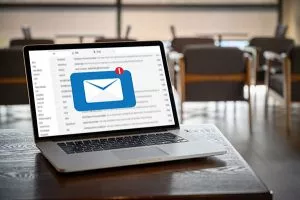Sending regular emails can keep you top-of-mind for prospects and let you demonstrate your expertise so that when they need a hand with IT, you’re the first one they contact. We’ve explored the fundamentals of email campaign management in previous posts, but what goes in your emails warrants its own discussion. In particular, let’s look at regular email newsletters, which you might send weekly, bi-weekly, or maybe just monthly depending on your ability to produce content for it. Regardless of how often you send, here’s what you’ll want to include in each newsletter.
Useful Content
Your newsletter should be useful first, sales-oriented second, but the type of content you include may depend on who it goes to. You may wish to send a different newsletter to prospects than you do to existing customers. For a prospect, you may have success illustrating ways outsourced IT can save a company money or why investing in great hardware can lead to a more productive workforce. Existing customers might like suggestions on how to avoid scams and ransomware, or general tech tips that make their lives easier. Whatever the case, newsletters should contain plenty of engaging content, and there are a few ways to structure an email around it. Remember that you don’t have to produce lots of original content to be helpful, and in fact, some email newsletters solely consist of links to videos and articles that exist all over the web. Linked content can be more business-focused like a productivity article on Forbes, or something more entertaining like a Wired piece about what’s going on with the latest drone tech. In any case, here are types of content you can put in a newsletter:- A full blog article – Post the full content of an article in an email with a link to your blog as well as a short promotional call to action (CTA; see section below).
- Article snippets – Post portions of several articles with links back to the full pieces on your blog.
- A list of helpful links – Curate a themed list with links to articles either on or off your website. This can be as simple as the week’s top 5 moments in technology.
- A combination – Use a mix of the above to create a unique newsletter with original content, links, and other useful info. Just don’t get crazy adding too much content. Short and sweet is always the way to go.

Calls to Action
Outside of content, you’ll want to include a subtle offer. For prospects this might be a free evaluation, a free month of your services, or something of the sort. For existing customers, it might be a hardware or other promotion or, in some cases, nothing at all. The promotional content should take a back seat to the useful content, but it’s wise to have some sort of call to action in a banner or sidebar that reminds people what you do and lets them know you have a great offer for them. This is particularly important if you choose to share links to websites other than your own—prospects should always have an easy way to get to your website.Personalization
Do you ever get emails that begin with “Dear friend” or just “Hello”? They aren’t very warm and inviting. Many email campaign management tools will let you automatically inject a person’s name into the email, which is the most basic step you can take to make it feel more personal. Additionally, consider changing the “from” address to something other than your company’s name. You may have more success if your email is sent from someone on staff, or even your CEO. Little personal touches like these can go a long way in garnering more opens and clicks.Personable Writing
Too many businesses write newsletters that sound like a sales pitch. Write like you’re a regular person talking to another person, because you are. Use a friendly, inviting tone, keep jargon to a minimum, and offer helpful information. Don’t be afraid to add some personality and character—your business can stand out a lot just by adding a little “pop” to the language you use.Have a Way to Review Analytics
Lastly, you’ll want to track how many people opened your emails and clicked a link, how many opened and didn’t click, and how many deleted your emails before looking at them. Most email campaign tools have this technology built in, but be sure you’re familiar with the reporting tools so you can get an idea of how successful your emails are.Keep it Consistent
As you begin sending a newsletter and sharing content, aim for consistency. It’s easy to deprioritize newsletters in favor of other things, but you won’t see the fruits of your labor unless you set a schedule and stick to it. In time, you can grow your marketing list, widen your network, and start turning more prospects into awesome customers.You May Also Like
- Backup and Disaster Recovery Business Continuity Channel: MSPs / VARs / SIs Cloud Data Management Data Protection Data Resilience
Arcserve Reaffirms Commitment to MSPs with Latest ShadowProtect SPX Release, as the Cloud Services Sunset Period Concludes
July 29th, 2024 - Channel: MSPs / VARs / SIs
Tech Conversations - Beyond the Arc: The Role of Transparency in Fostering Client Trust
July 19th, 2024 - Channel: MSPs / VARs / SIs
Why “Contract to Hire” IT Positions Don't Make Sense for Anyone
March 19th, 2024
